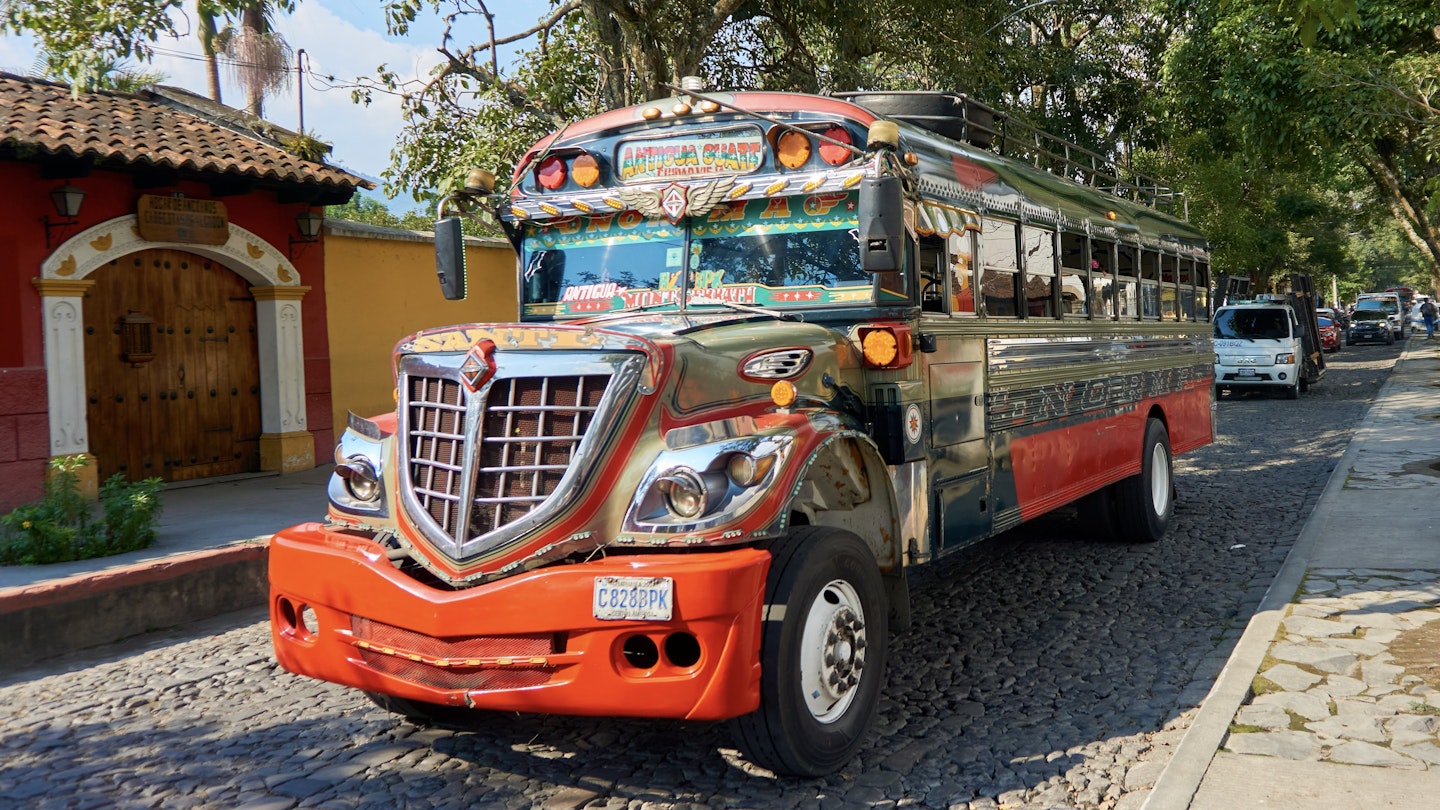
How to explore Guatemala by bus, boat, motorcycle and more

Aug 15, 2024 вҖў 11 min read

In Guatemala, make like the locals do and catch a reliable if slow (and always decked-out) вҖңchicken bus.вҖқ Shutterstock
With its pyramids, ruins, jungles, volcanoes and thriving Mayan culture, Guatemala represents the best of Central America.
Exploring this fascinating corner of the Americas is a treat вҖ“ yet getting from A to B may take longer than you think.
In a place where the average income hovers around US$400 a month, owning a car is out of reach for most Guatemalans, so the vast majority of locals rely on public transport to get around. This means buses are almost always packed вҖ“ but also that thereвҖҷs almost always a bus going where you want to go.
Travelers will be pleased to hear that GuatemalaвҖҷs public transport system is extensive and inexpensive, if not always particularly efficient. Buses will reliably get you to your destination вҖ“ but you should board prepared for long travel days, bumpy roads and some discomfort.
Short distances in the small country are misleading: with poorly maintained, winding roads, slow-moving traffic and frequent road closures, it will almost always take longer to get there than you think. Options exist for explorers of all budgets вҖ“ and in such a vivid country, the journey is all part of the experience.
Here are our tips for getting around in Guatemala.

Buses are the cheap and easy way to get around in Guatemala
Currently, there are no passenger services on GuatemalaвҖҷs limited rail network, making the main form of mass transportation the humble bus. Buses in Guatemala come in two classes: comfortable first-class coaches and second-class вҖңchicken busesвҖқ вҖ“ revamped US school buses that go almost everywhere.
First-class buses вҖ“ also known as вҖңexpress busesвҖқ вҖ“ operate on busy routes between major destinations, with regular services from Guatemala City to Quetzaltenango, Huehuetenango, Flores (for Tikal) and Panajachel (for Lago de AtitlГЎn). Buses also connect major cities to some beach destinations as well as to international border crossings with Honduras, Mexico, El Salvador and Belize.
Not all bus lines are created equal, however. Some buses have toilets; others donвҖҷt. Some have a TV screen up front playing music videos or action movies dubbed into Spanish, while others let you enjoy the scenery or have a snooze in peace and quiet. First-class buses are about double the price of their second-class counterparts, but theyвҖҷre also much faster, safer and more comfortable.
Known locally as camionetas, chicken buses are more frequent than first-class coaches, and they reach pretty much every city, town and village in the country. These retired US school buses are almost universally given a new life and a bold new look, painted with bright primary colors and adorned with a riot of chrome trimmings. You wonвҖҷt see many chickens on the buses these days, but they do transport just about anything else.
Buses stop frequently to pick up and drop off passengers. WhatвҖҷs more, shopkeepers in smaller towns often use chicken buses to transport goods, meaning there isnвҖҷt much space in the aisles. TheyвҖҷre slow going, itвҖҷs true вҖ“ but theyвҖҷre also one of the best ways to meet locals.
Knowing some basic Spanish is helpful if youвҖҷre traveling by chicken bus. While stops along the way arenвҖҷt clearly marked, if you let the driver where you want to go, theyвҖҷll alert you when your destination approaches. With basic Spanish, you can also ask fellow passengers about the correct fare so you donвҖҷt end up paying twice as much as everyone else.
Chicken buses might be better for short trips than for long, all-day journeys. TheyвҖҷre cramped and uncomfortable, especially if youвҖҷre tall (they were made for American school kids, after all). Large backpacks will be put on the roof, so itвҖҷs best to travel with a small day pack rather than exposing your belongings to the weather (and prying hands).
Opportunistic theft is common on these buses, so be alert and keep an eye on your valuables. If someone starts a conversation with you and inches closer, put your hand over your bagвҖҷs zipper. While most interactions are genuine, robbers sometimes strike up a conversation to distract you so they can relieve you of your wallet, phone or camera.

GuatemalaвҖҷs microbuses offer a bit more comfort for a higher fare
In some areas of Guatemala, youвҖҷll find minibuses вҖ“ known locally as microbuses вҖ“ that follow paved roads between major towns or run on local routes in larger cities. These small buses are more expensive than the chicken buses, but theyвҖҷre also more comfortable.
Expect more legroom, plus working shock absorbers that make the ride far less bumpy than on a rickety chicken bus. Some even have air-conditioning, which is always welcome in this tropical climate, particularly for routes in the lowlands. As with chicken buses, large pieces of luggage will go on the roof, but thereвҖҷs less risk of theft.
Tourist shuttles offer quick transfers but less atmosphere
Tourist shuttles (small vans or minibuses) operate between all the major tourist destinations in Guatemala. Services also run across borders to destinations such as San CristГіbal de las Casas in Mexico, Playa El Tunco in El Salvador and the ruins of CopГЎn in Honduras.
Shuttles are usually double the price of the chicken bus; whatвҖҷs more, youвҖҷll travel in a bit of a tourist bubble, without locals as fellow passengers. Yet because of the comfort, the convenience вҖ“ many shuttles will drop you off at your hotel or hostel вҖ“ and the chance to share information with fellow travelers, theyвҖҷre a great option for longer journeys.
You can book shuttle seats at any local travel agency, even though the shuttle may actually depart from a different location. For example, if you book a shuttle from San Pedro La Laguna on Lago de AtitlГЎn to San CristГіbal de las Casas in Mexico, youвҖҷll first need to catch an early boat to Panajachel, where the shuttle journey begins. (Check with the travel agency to confirm if the price of the ticket includes your boat fare.)

Driving in Guatemala brings the freedom to go wherever you want
If you like the freedom of traveling according to your own schedule, driving is always an option. YouвҖҷll need an international driverвҖҷs license to drive in Guatemala only if youвҖҷre from a country with a non-Roman alphabet; other travelers can use a valid driverвҖҷs license from their home country for the first 30 days.
Car rental is easy to arrange at airports, major cities and other tourist hot spots, provided youвҖҷre at least 25 years old. Always check the insurance conditions: you may not be covered for loss or theft, for example, so you should always park in a secure place. Gasoline is more expensive in Guatemala than it is in the United States but cheaper than in Canada, Australia and Europe.
You can bring your own car into the country, though it involves quite a bit of bureaucracy. An alternative is to rent a private car with a driver. This is easy to arrange via travel agencies in most tourist destinations in the country, and it takes the stress out of driving on unfamiliar roads.
Be aware that getting behind the wheel in Guatemala requires nerves of steel: reckless driving is common, and while the main roads are generally in good condition, visibility can drop massively at night or in rainy or foggy conditions. Smaller towns have narrow streets, and it can be difficult to find safe parking. Driving at night is never a good idea: in addition to low visibility and the possibility of animals wandering onto the road, intoxicated drivers and armed robberies are a real risk.
Taxis and rideshares are handy for local hops
Metered taxis are common in Guatemala City, Antigua and Quetzaltenango; in smaller towns and around Lago de AtitlГЎn, theyвҖҷre almost non-existent. Whether thereвҖҷs a meter or not, you may need to negotiate a fare before starting your journey.
Is there Uber in Guatemala? Yes, but . ItвҖҷs a good option for exploring these cities: itвҖҷs safe, the price is fixed, and if you donвҖҷt speak Spanish, you can leave everything to the app.

Tuk-tuks serve as taxis in smaller towns
More commonly known as tuk-tuks, moto-taxis are found in just about every town in Guatemala, although theyвҖҷre much less common in Guatemala City and Quetzaltenango. Within towns, these small vehicles are probably the most useful form of public transport because theyвҖҷre cheap and quick.
In some areas, tuk-tuks travel to nearby towns and villages. Alternatively, they may travel to the outskirts of town, where you must transfer to another tuk-tuk to travel onward. Be sure to check how to recognize the officially licensed tuk-tuks in each town you visit; regulations differ from one destination to the next.
To flag down a tuk-tuk, simply put out your hand and make an up-and-down waving motion as if youвҖҷre patting an imaginary child on the head. In practice, if you stand by the side of the road, you may find that tuk-tuks stop and ask if you need a ride.

Pickup trucks ferry passengers in some rural areas
Tuk-tuks have largely replaced the pickup truck вҖ“ or picop, as locals call them вҖ“ as the preferred method of cheap local transportation. However, youвҖҷll still find pickup trucks functioning like local buses in less touristy and more rural areas, not least because theyвҖҷre better suited to navigating rough dirt roads.
Because they have open tops, theyвҖҷre best for sunny days. And youвҖҷll need to hang on for dear life. Tell the driver where you want to get off or, if you know the stop, simply bang on the side of the truck to let the driver know you are ready to get out.

Bicycles and motorcycles are an option for the brave
Cycling around Guatemala is not for the faint of heart, but it is possible. The scenery is stunning, but know youвҖҷll be dealing with either sweltering weather in low-lying areas or ridiculously steep climbs in the highlands. And bike paths? What bike paths? If youвҖҷre game after all that, you can rent bikes (including mountain bikes) in most tourist centers, and it's easy enough to cycle around in town or follow the tracks that wind around Lago de AtitlГЎn and Antigua.
Motorbikes are becoming increasingly common in Guatemala; in many towns, itвҖҷs not unusual to see a whole family with children riding on one bike, without a helmet in sight. To cover longer distances between towns, you will definitely need a helmet. For both motorcycling and cycling, itвҖҷs recommended that you avoid the busy main roads, where speeding trucks and buses are a real danger. Motorcycles are available for rent in Antigua and around Lago de AtitlГЎn.
Air travel is useful for avoiding long road journeys
Since Guatemala is only about the size of Tennessee and smaller than England, traveling by plane domestically isnвҖҷt common. It is an especially useful option for avoiding the long bus ride to Flores and Tikal in the north, or for traveling from Flores to Belize.
offers scheduled flights between Guatemala City and Flores or Puerto Barrios, while runs from Flores to Belize City.
If you have a decent budget, you can charter a flight to other destinations around the country with , which operates out of La Aurora International Airport in Guatemala City.

Boats cruise down jungle rivers to the coast
A few places in Guatemala are only accessible (or more easily accessible) by boat, including Livingston on the Caribbean coast and Jaibalito on the shores of Lago de AtitlГЎn. Where they are available, boats are often the preferred mode of transport because theyвҖҷre quicker and more direct than going by road. Traveling from Panajachel to San Pedro La Laguna on the opposite shore of Lago de AtitlГЎn, for example, takes about half an hour by lancha (public motorboat), compared to 2 hours by road.
While few locals wear them, itвҖҷs best to make use of the life jackets provided when you get onto a boat, for lanchas can вҖ“ and sometimes do вҖ“ capsize, especially on windy days. Sitting up front in the prow is great for feeling the wind in your hair; expect to get doused with lake or river water. YouвҖҷll find the ride less bumpy and drier if you sit near the back.
If your travel day includes a boat ride, allow plenty of time for the journey. Lanchas rarely operate on a set schedule and only leave when the boat is full. This can take just a few minutes early in the morning or an hour or so later in the day.
Accessible travel in Guatemala
Guatemala isnвҖҷt an easy destination for travelers with mobility issues. While a law guarantees the rights of disabled people, and makes it illegal to discriminate against people with disabilities, in practice little is done to enforce the rules.
Wheelchair-accessible accommodation is scarce, and wheelchair-accessible transport is nearly non-existent. Still, youвҖҷll find that most Guatemalans are happy to help in any way they can. Traveling with your own car and driver is usually the easiest option.
Explore related stories

Public Transport
How to get around in Honduras, from the cloud forests to the beachesJan 6, 2024 вҖў 6 min read

 Public TransportGetting around Central America is easy by bus, plane and boat
Public TransportGetting around Central America is easy by bus, plane and boatMar 19, 2022 вҖў 8 min read


 Road TripsThe 7 best road trips in Arizona to discover ancient culture and modern wonders
Road TripsThe 7 best road trips in Arizona to discover ancient culture and modern wondersNov 8, 2024 вҖў 6 min read




